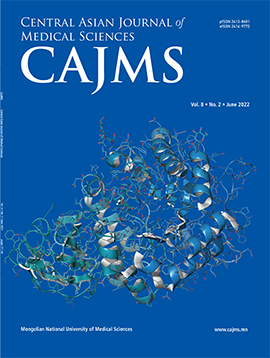Risk Factors for Hepatitis B and C Infection in 10 to 40 Year Olds in Mongolia
DOI:
https://doi.org/10.24079/cajms.2019.12.009Keywords:
Hepatitis, Risk Factors, Mongolia, Young Adult, ImmunizationAbstract
Objective: To determine the prevalence of hepatitis B and C infection and its risk factors in Mongolians from 10 to 40 years of age. Method: Randomly selected Mongolians underwent phlebotomy and completed a questionnaire about their medical and family history and risk factors. Participants were screened for qHBsAg, anti-HBs, HBeAg, anti-HBe, anti-HBc markers, and Anti-HCV. Results: 6811 people, 2900 (42.7%) males, and 3911 (57.3%) females participated. Most were from Ulaanbaatar (4685, 69%), with the remaining 2126 (31%) from rural areas. Seven percent were HbsAg positive, 4.2% were HCV positive. Of those10-20 years of age, 5.8% (29) had hepatitis B, 6% (17) had hepatitis C. Of those 21 to 40 years of age, 94.2% (469) had hepatitis B, and 94%(268) had hepatitis C. Children whose mother was HBsAg positive were at higher risk of HBsAg positivity (OR 2.152; 95% CI 1.4; 3.2, p < .0001) as well as those with male gender (OR 1.703; 95% CI 1.17;2.46, p < .005), those phlebotomized for lab tests (OR 1.768; 95% CI 1.14; 2.74, p = .011) ,and those immunized against hepatitis B (OR 0.508; 95% CI 0.35; 0.74, p < .0001). HCV infection was associated with history of dental procedures (OR 1.681; 95% CI 1.01; 2.79, p = .045), using glass syringes (OR 2.131; 95% CI 1.54; 2.95, p < .0001), and previously used needles (OR 2.411; 95% CI 1.09;5.29, p = .028). Conclusions: Among the Mongolian population between 10 and 40 years of age, 7.3% were HbsAg positive, 4.2% were Anti-HCV positive. The risk factors were maternal HbsAg positivity, utilization of glass syringes, reusing needles, phlebotomy for laboratory tests, receiving dental treatment, and the absence of hepatitis B immunization.
Downloads
261
Downloads
Published
How to Cite
Issue
Section
License
Copyright (c) 2019 Mongolian National University of Medical Sciences

This work is licensed under a Creative Commons Attribution-NonCommercial 4.0 International License.




